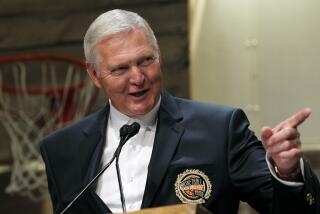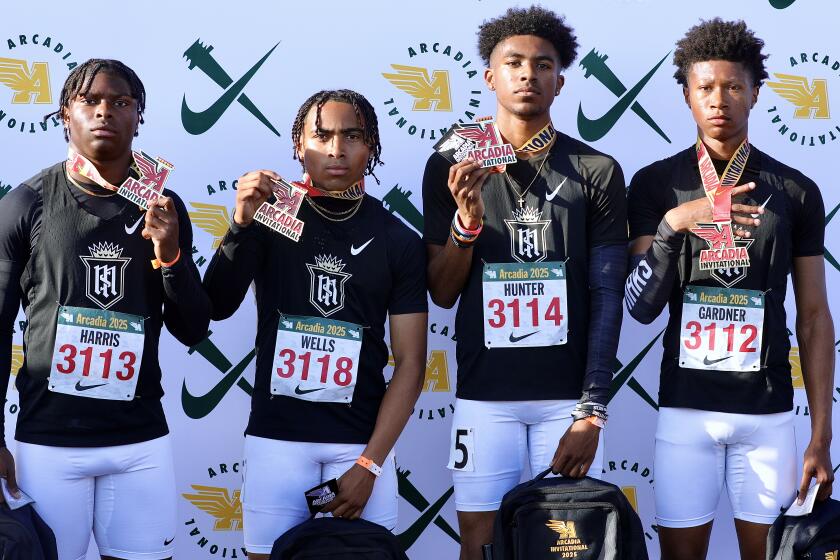A Tempest That Will Blow Over
- Share via
“What’s in a name?” Shakespeare wanted to know.
Well, “What’s in a number?” Michael Jordan would like to know.
Would he play as sweet under any other number than 23?
Palpably, Michael thinks not. Perhaps you noticed the digital flap that took place when Michael switched jerseys in the NBA playoffs recently, reverting to the No. 23 that had long since been retired to the arena rafters when Michael left basketball for a new love, baseball. It was, Shakespeare might say, a star-crossed love. Unrequited. You can’t dunk a curveball.
So, Michael came back to the hardwood court and a ball that was more his size, a comfort zone where “Air Jordan” was a nickname that referred to his soar to the basket and not his swing at a slider.
Alas! On his return, he decided to play under an assumed number--45.
Athletes, as a class, will never admit they’re superstitious. Having denied it, however, they will proceed to wear the same socks and underwear during a hitting streak. They will take precisely the same route to work on a winning streak, will step carefully over foul lines and observe all the ways to ward off bad luck.
Some race drivers have a fit if they’re issued a green car and, although some athletes defy the superstition of triskaidekaphobia and wear 13, there once was a football coach, Buddy Parker, who wouldn’t accept a hotel room whose numbers added up to 13--904 or 823, for example.
Ballplayers are careful not to vex the gods of sport. They are the spiritual inheritors of the guys who used to throw maidens into volcanoes to placate the angry deities.
The league would have thought Jordan could lead the world wearing his social security number, but when he made the playoffs and began missing layups and having the ball stolen from him by rookies, he knew where the blame lay. Those accursed digits on his back.
If he didn’t, an Orlando player named Nick Anderson, whose number nobody knows, was incautious enough to point it out to him, divesting himself of the opinion that the Chicago Bulls’ No. 45 was not the same player the Bulls’ No. 23 had been.
That did it. The next game, Michael Jordan appeared wearing No. 23. And playing like it.
The NBA, of course, had a fit. It has all to do with marketing and dollars, of course. It usually does. Michael had just made thousands of souvenir jerseys bearing 45s on their backs obsolete.
“Twenty-three is me,” Jordan told the press in Orlando the other day. “What’s the big hype?”
Everyone, of course, has a lucky number. I mean, how would lotteries survive?
Sports heroes are no different. Look at the number of 32s in the games people play. Jim Brown wore it. So did Sandy Koufax. O.J. Simpson (You remember him?). Magic Johnson.
It’s interesting that one of the reasons the league fined Jordan for his illegal change was because it had just turned down Shaquille O’Neal’s request to change his number from 32 to 33, Kareem Abdul-Jabbar and Larry Bird’s number.
Sports put numbers on players for the soundest of economic reasons--to sell programs. But do you know what Babe Ruth’s number was when he was setting most of his home run records? Nothing. He didn’t have one. The New York Yankees didn’t issue numbers until 1929.
Then they were issued by position in the batting order. That’s how Ruth became No. 3 and Lou Gehrig No. 4. Ruth batted third, Gehrig batted cleanup.
Football had stolen a march on baseball, issuing numbers as early as 1920. The Four Horsemen wore numbers. So did Red Grange--No. 77.
Some years ago, in the ‘60s, teams began to put not only numbers but names on the backs of uniforms. Presumably, in the natural order of things, they will soon add age, height, weight, birthplace and perhaps religious affiliation, political party and blood type.
We’ve become a society of numbers, anyway. Pro golfers and tennis players are almost the only athletes who compete un-numbered. Back in the ‘40s and early ‘50s, a Chicago entrepreneur, George May, posted the first $100,000 golf tournament and made it a condition of qualifying that the players wear numbers on their backs. Ben Hogan refused. He considered it demeaning. Today, caddies wear the players’ numbers in most tournaments but not in all.
Wayne Gretzky, of course, makes do with No. 99, but the highest you’ll see in the baseball Hall of Fame is Don Drysdale’s 53. Superstars are usually identified by single digits. Mickey Mantle was No. 7, Stan Musial No. 6, Joe DiMaggio No. 5. But Willie Mays wore No. 24 and Henry Aaron wore No. 44, as did Reggie Jackson.
Michael Jordan doesn’t need his name or number on his back, any more than Ruth did. He could play in a mask and not fool anybody. But it’s too bad he got superstitious. He might have become the first guy to retire two numbers in the same sport.
Actually, he’s got it all wrong. The only number any athlete should ever fear is 40.
More to Read
Go beyond the scoreboard
Get the latest on L.A.'s teams in the daily Sports Report newsletter.
You may occasionally receive promotional content from the Los Angeles Times.










